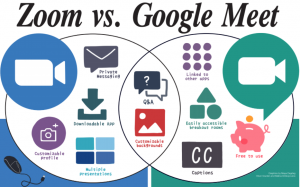Google Meet
December 19, 2020
Google Meet debuted in 2017 as an enterprise-friendly alternative to Google Hangouts. Although Google Meet was initially only available for G Suite accounts, it was made available for all users in May 2020. SCHS students and teachers are in a position where they must rely on either Google Meet or Zoom to conduct their schoolwork, many of whom prefer Google Meet.
As a Google platform, Meet can be easily utilized with Google Calendar and Gmail. For school, each Google Classroom has a built-in Meet link, granting teachers and SCUSD control over school-related Meets. With recently added features, such as polls, break-out rooms, hand-raising and Q&A, Google Meet provides teachers with the ability to integrate as much engagement as possible.
Math teacher Susana Hernandez believes Google Meet’s poll feature allows her to be more interactive with her students.
“Once the class Meet is over, they actually send me that data (from a poll) in an excel spreadsheet,” Hernandez said. “As a teacher, it’s really nice to have all that data in real time and be able to go back and refer to it so I can check in with certain students or figure out if I need to do any remediation.”
Google Meet and Zoom differ in certain ways, such as with usernames in meetings. On Zoom, a user can change their display name, whereas on Google Meet, the Google account name is displayed.
Freshman Lucas Bates believes that Zoom’s feature to change a user’s display name can be problematic.
“There is the problem of not putting your full name, and the teachers would have to ask,” Bates said. “And Google Meet just puts your name, so the teachers don’t have to worry about that.”
Video call platforms should be user-friendly for optimal student and teacher performance. Senior Jannah Khan noted how Zoom is an application and Google Meets is a Chrome tab, enabling easier multitasking.
“When I used Zoom, it was harder to go on different websites because I couldn’t really see the same page at the same time,” Khan said. “For Google Meet, it’s easier to go on different websites and easier to do work.”
Along with usability, the quality of meetings during class plays a vital role in the distance learning environment. Some feel Google Meet allows multiple users to attend a Meet with a better connection compared to Zoom.
“The connection quality is better (on Google Meet), so when a teacher is talking, it doesn’t freeze as much, or at all,” Bates said. “On Zoom, it would freeze, and you would have to ask and get clarification.”
Along with Google Meet’s standard features, there is the option to turn on closed captions, allowing people who are deaf or hard of hearing to understand what their teachers are saying and stay on track with the class.
“It allows a lot of people to use it, to use the application like I mentioned before, the closed captioning feature,” senior Jordan Liebes said. “For – I guess the word would be – anti-ableist, or if someone is deaf, you can use the closed captioning.”
Despite Google Meet’s rough start with a small selection of features, many feel that the platform has expanded beyond Zoom’s capabilities, and it is ultimately the better way to engage online.
“It seems like a much more viable platform…” Liebes said. “All in all, there’s more meat on the bones now with this program (Google Meet) than the other ones.”


